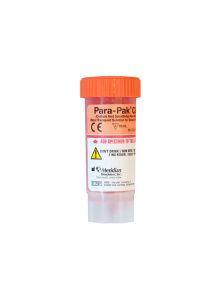Test Name
Yersinia Culture (YERCUL)
CPT Codes
87046
Methodology
Culture
Turnaround Time
5 days
Specimen Requirements
Specimen Type:
Stool
Volume:
5 mL
Collection Container:
Para-Pak™ C&S (Culture & Sensitivity) Stool Transport System
Transport Temperature:
Refrigerated
Stability
Ambient:
2 hours
Refrigerated:
Preserved – 24 hours
Unpreserved – 2 hours
Frozen:
Unacceptable
Additional Information
Background Information
Bacterial, parasitic, and viral agents can cause infectious gastroenteritis. Approximately 48 million people become ill and 128,000 require hospitalization from foodborne diseases in the United States each year.1 Enterohemorrhagic Escherichia coli (EHEC) is one of the top five causes of foodborne illness requiring hospitalization in the United States.1 Most clinical laboratories that perform enteric cultures on stool samples routinely include media and methods to rule out Campylobacter spp., Salmonella spp., Shigella spp., and EHEC.
Shigella, which accounts for less disease prevalence in the U.S. (~14,000 cases/year), is highly infectious and its detection in all stool samples is important to prevent further disease from spreading person to person. Yersinia enterocolitica can also cause foodborne disease, but at a much lower incidence; consequently, most laboratories do not routinely look for this pathogen. The incidence of Y. enterocolitica, as reported by CDC Food Net activities, is about one culture-confirmed case per 100,000 population per year. This compares to the > 1 million cases of Salmonella and > 800,000 cases of Campylobacter reported annually to CDC in the U.S.2 Blood transfusion reactions have occurred from blood products contaminated with Y. enterocolitica, however, gastroenteritis is not usually a part of the resultant bacteremia.
Y. enterocolitica can cause gastroenteritis in an individual who has consumed contaminated food or water. Y. enterocolitica has been isolated from raw meats, such as beef, lamb, pork and chicken, but can also be found in cooked, pre-packaged deli meats. Consumption of raw or improperly cooked pork is the main source of gastroenteritis in humans, with the specific association with improperly prepared and handled pork chitterlings.3,4,5,6 Drinking unpasteurized milk, untreated water, or coming into contact with infected animals also can be the source of infection.
The severity of the disease is related to the specific serotype of Y. enterocolitica as well as load of organism consumed. The range of diseases associated with Y. enterocolitica is self-limited gastroenteritis to terminal ileitis, to mesenteric lymphadenitis that is often mistaken as appendicitis. Occasionally, skin rash and joint pains can accompany Yersinia gastroenteritis.1,3
Children are more commonly diagnosed with Y. enterocolitica than adults. Patients with gastroenteritis associated with Yersinia are more likely to present with fever, diarrhea, and abdominal pain that can last for seven days. A carrier state of the organism can ensue for up to several months. Septicemia can result if organisms migrate out of the gastrointestinal tract via the lymphatics and find their way to lymph nodes. Persons at the highest risk for systemic disease are the elderly and immunocompromised populations. In particular, persons with underlying metabolic diseases that are associated with iron overload (hemochromatosis), cancer, liver disease, and steroid therapy are at the highest risk of more serious Y. enterocolitica disease. A case of ileal perforation post gastroenteritis has been reported with a review of other surgical complications of Yersinia gastroenteritis.6
Clinical Indications
A request for Yersinia culture from stool should be made if a patient is suspected of having gastroenteritis associated with Yersinia, for example, when there has been exposure to undercooked pork chitterlings, or when routine stool cultures are negative for Salmonella and Campylobacter. In addition, patients presenting with diarrhea and associated symptoms of appendicitis and/or septicemia should be considered for a Yersinia culture request.
This test should be done as an adjunct to the routine culture and not in place of it.
Children, the elderly, and immunocompromised patients are the more likely patients at risk for Yersinia gastroenteritis.
Interpretation
Yersinia enterocolitica can grow on most routine laboratory media, including Maconkey’s agar, but grows more slowly than other members of the normal GI flora Enterobacteriaceae. Cefsulodin-irgasan-novobiocin (CIN) agar will be planted in addition to a Maconkey’s agar when a request is made for isolation of Y. enterocolitica.
Most results should be available within 48-72 hours after collection and processing of the stool samples.
Growth and identification, specifically of Y. enterocolitica, will be considered a positive result; no growth as a negative result.
Serotyping of the Y. enterocolitica is not performed routinely in clinical laboratories and is not widely available in reference laboratories.
Most cases of Yersinia gastroenteritis are self-limited and do not require treatment; however, if there is concomitant systemic disease and/or if the patient is immunocompromised, susceptibility testing can be performed.
Limitations
Overgrowth with normal flora GI bacteria and/or other GI pathogens may limit the growth of Y. enterocolitica.
Culture of stool samples after beginning treatment may limit detection.
Methodology
Y. enterocolitica is a gram-negative bacterium that can be isolated in culture from stool specimens.
Stool should be submitted to the laboratory within two hours of collection or transported in Cary Blair transport media and refrigerated if there will be delays. The order should be placed for a Yersinia culture when the stool is submitted.
Cultures are performed seven days per week.
References
1. http://www.cdc.gov/foodborneburden/2011-foodborneestimates.html. CDC website.
2. Long C, Jones TF, Vugia DJ, Scheftel J, Strockbine N, Ryan P, Shiferaw B, Tauxe RV, Gould LH. Yersinia pseudotuberculosis and Y. enterocolitica infections, FoodNet, 1996-2007. Emerg Infect Dis. 2010;16:566-7.
3. Wanger, A. Chapter 44. Yersinia. In Murray PR et al. (eds). Manual of Clinical Microbiology 9th ed. ASM Press: Washington, 2007.
4. Fosse J, Seegers H, Magras C. Prevalence and risk factors for bacterial foodborne zoonotic hazards in slaughter pigs: a review. Zoonoses Public Health. 2009;56:429-54.
5. Centers for Disease Control and Prevention. Yersinia enterocolitica gastroenteritis among infants exposed to chitterlings—Chicago, Illinois, 2002. MMWR Morb Mortal Wkly Rep. 2003;52:956-8.
6. De Berardis B, Torresini G, Brucchi M, Marinelli S, Mattucci S, Schietroma M, Vecchio L, Carlei F. Yersinia enterocolitica intestinal infection with ileum perforation: report of a clinical observation. Ata Biomed. 2004;75:77-81.

